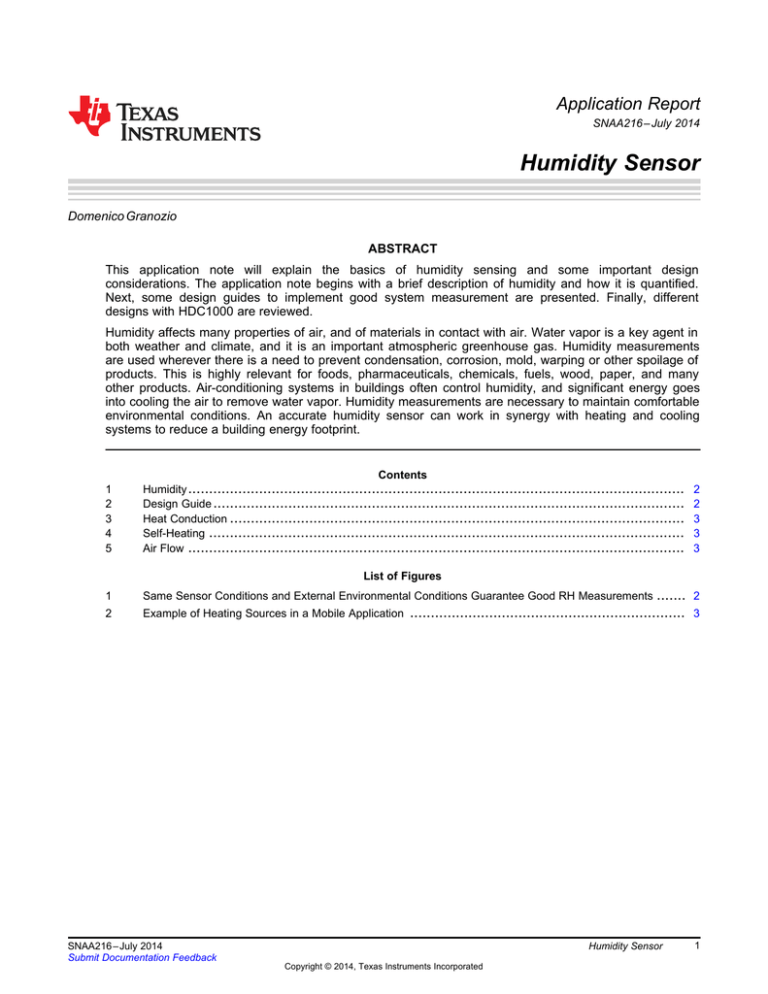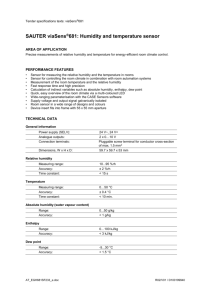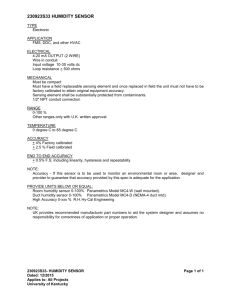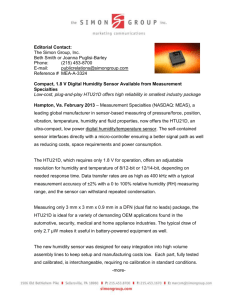Humidity Sensor - Texas Instruments
advertisement

Application Report SNAA216 – July 2014 Humidity Sensor Domenico Granozio ABSTRACT This application note will explain the basics of humidity sensing and some important design considerations. The application note begins with a brief description of humidity and how it is quantified. Next, some design guides to implement good system measurement are presented. Finally, different designs with HDC1000 are reviewed. Humidity affects many properties of air, and of materials in contact with air. Water vapor is a key agent in both weather and climate, and it is an important atmospheric greenhouse gas. Humidity measurements are used wherever there is a need to prevent condensation, corrosion, mold, warping or other spoilage of products. This is highly relevant for foods, pharmaceuticals, chemicals, fuels, wood, paper, and many other products. Air-conditioning systems in buildings often control humidity, and significant energy goes into cooling the air to remove water vapor. Humidity measurements are necessary to maintain comfortable environmental conditions. An accurate humidity sensor can work in synergy with heating and cooling systems to reduce a building energy footprint. 1 2 3 4 5 Contents Humidity ....................................................................................................................... Design Guide ................................................................................................................. Heat Conduction ............................................................................................................. Self-Heating .................................................................................................................. Air Flow ....................................................................................................................... 2 2 3 3 3 List of Figures ....... .................................................................. 1 Same Sensor Conditions and External Environmental Conditions Guarantee Good RH Measurements 2 2 Example of Heating Sources in a Mobile Application 3 SNAA216 – July 2014 Submit Documentation Feedback Humidity Sensor Copyright © 2014, Texas Instruments Incorporated 1 Humidity 1 www.ti.com Humidity Humidity is the presence of water vapor in air (or any other gas). In ambient air there is typically about 1 % water vapor, but this can vary to a large extent. Dry environments can cause irritation of the respiratory tract, skin and eyes. It also increases the chances of an electrostatic discharge from the body to a conductive surface. Humidity is expressed in several different ways : Relative humidity – is the amount of moisture in the air compared to what the air can "hold" at that temperature. This is the most common used measure of humidity. Usually expressed as a percentage, with the symbol “%rh”, for example “The humidity is 51 %rh”. The term “relative humidity” is commonly abbreviated to RH (note this is different from the unit symbol: %rh). Pwater vapor RH % u 100 Psaturation water vapor (1) where Pwater vapor is the pressure of the water vapor in the air at given temperature Psaturation water vapor represents the max quantity of water vapor that the air can hold at given temperature. Dew point (or dew-point temperature) - the temperature at which condensation (dew) would occur if a gas was cooled at constant pressure. Dew point is a useful measure for two reasons: • The dew point tells us what temperature to keep a gas at, to prevent condensation • Dew point is an absolute measure of the gas humidity (at any temperature) and relates directly to the amount of water vapor present (partial pressure of water vapor). Dew point is expressed in temperature units. The dew point can be calculated by using the relative humidity and temperature as inputs. § § RH · E u T · O u ¨ ln ¨ ¸ ¸ © 100 ¹ O T ¹ © Dp § § RH · E u T · E ¨ ln ¨ ¸ ¸ © © 100 ¹ O T ¹ (2) For the range from –45°C to 60°C, Magnus parameters are given by β =17.62 and λ=243.12 °C 2 Design Guide The accuracy of a RH and temperature measurement depends on the sensor accuracy and the set up of the sensing system. The HDC10x0 sensors sample relative humidity and temperature of their direct environment. It is thus important that the local conditions at the sensor correspond to the conditions under test. External Environmental Conditions System Case Sensor Conditions RH SENSOR Figure 1. Same Sensor Conditions and External Environmental Conditions Guarantee Good RH Measurements More generally, correct sampling is about making sure the measurement is representative of the condition you want to measure. Avoid temperature and relative humidity (RH) deviations between the sensor and the environment. A usual root cause for temperature deviations are heat sources, while RH deviations are mostly caused by temperature deviations as well as slow response times. For any temperature or humidity change of the environment, the sensor requires a certain amount of time to equilibrate with the new environmental conditions. To get precise data it is recommended to improve the response time of the sensor system. 2 Humidity Sensor SNAA216 – July 2014 Submit Documentation Feedback Copyright © 2014, Texas Instruments Incorporated Heat Conduction www.ti.com In order to optimize the measurement of the relative humidity consider the following design constraints: • Heating – Conducted – Self-heating • Air flow 3 Heat Conduction The most common root cause for local heating of the sensor is due to thermal conduction from a nearby heat source (power electronics, microprocessors, displays, etc). Temperature change causes relative humidity change. Isolating the sensor from heat source is very important. To isolate the sensor from the heat source, special attention needs to be paid to circuit board design. As thermal conduction mostly occurs through the metal in the PCB, thin metal lines and sufficient distances between the sensor and potential heat sources are recommended. Further, heat conduction can be decreased by milling slots in, and removing (etching) all unnecessary metal from the PCB around the sensor SLOT RH SENSOR Battery SLOT LCD DC/DC uC PCB Figure 2. Example of Heating Sources in a Mobile Application 4 Self-Heating The HDC10x0 humidity sensors have very low power consumption in sleep mode so their self-heating is very limited. The power consumption during the measurement increases and it might cause self-heating. In order to mitigate this effect it is suggested to not exceed more than 2 measurements per second at high resolution (1 measurement of temperature and 1 measurement of relative humidity).The length of the active state depends on the acquisition time: higher the resolution, longer is the active state. 5 Air Flow In order to monitor outside humidity by using the sensor mounted in the device a design with air flow around the sensor is favorable in terms of response times. Even if there is no defined flow (such as static air condition in a room) a design with multiple openings and a possible flow is preferred. Placing the sensor close to the window and making the cavity around the sensor small helps improve the sensor's response time. In the following table are some possible designs which optimize the air flow to measure the outside humidity. SNAA216 – July 2014 Submit Documentation Feedback Humidity Sensor Copyright © 2014, Texas Instruments Incorporated 3 Air Flow www.ti.com Case 1) Multi windows (openings not aligned) System Case RH SENSOR Case 2) Multi windows (openings aligned) System Case RH SENSOR Case 3) Single window System Case RH SENSOR Case 4) Single window (flipped device ) System Case RH SENSOR 4 Humidity Sensor SNAA216 – July 2014 Submit Documentation Feedback Copyright © 2014, Texas Instruments Incorporated IMPORTANT NOTICE Texas Instruments Incorporated and its subsidiaries (TI) reserve the right to make corrections, enhancements, improvements and other changes to its semiconductor products and services per JESD46, latest issue, and to discontinue any product or service per JESD48, latest issue. Buyers should obtain the latest relevant information before placing orders and should verify that such information is current and complete. All semiconductor products (also referred to herein as “components”) are sold subject to TI’s terms and conditions of sale supplied at the time of order acknowledgment. TI warrants performance of its components to the specifications applicable at the time of sale, in accordance with the warranty in TI’s terms and conditions of sale of semiconductor products. Testing and other quality control techniques are used to the extent TI deems necessary to support this warranty. Except where mandated by applicable law, testing of all parameters of each component is not necessarily performed. TI assumes no liability for applications assistance or the design of Buyers’ products. Buyers are responsible for their products and applications using TI components. To minimize the risks associated with Buyers’ products and applications, Buyers should provide adequate design and operating safeguards. TI does not warrant or represent that any license, either express or implied, is granted under any patent right, copyright, mask work right, or other intellectual property right relating to any combination, machine, or process in which TI components or services are used. Information published by TI regarding third-party products or services does not constitute a license to use such products or services or a warranty or endorsement thereof. Use of such information may require a license from a third party under the patents or other intellectual property of the third party, or a license from TI under the patents or other intellectual property of TI. Reproduction of significant portions of TI information in TI data books or data sheets is permissible only if reproduction is without alteration and is accompanied by all associated warranties, conditions, limitations, and notices. TI is not responsible or liable for such altered documentation. Information of third parties may be subject to additional restrictions. Resale of TI components or services with statements different from or beyond the parameters stated by TI for that component or service voids all express and any implied warranties for the associated TI component or service and is an unfair and deceptive business practice. TI is not responsible or liable for any such statements. Buyer acknowledges and agrees that it is solely responsible for compliance with all legal, regulatory and safety-related requirements concerning its products, and any use of TI components in its applications, notwithstanding any applications-related information or support that may be provided by TI. Buyer represents and agrees that it has all the necessary expertise to create and implement safeguards which anticipate dangerous consequences of failures, monitor failures and their consequences, lessen the likelihood of failures that might cause harm and take appropriate remedial actions. Buyer will fully indemnify TI and its representatives against any damages arising out of the use of any TI components in safety-critical applications. In some cases, TI components may be promoted specifically to facilitate safety-related applications. With such components, TI’s goal is to help enable customers to design and create their own end-product solutions that meet applicable functional safety standards and requirements. Nonetheless, such components are subject to these terms. No TI components are authorized for use in FDA Class III (or similar life-critical medical equipment) unless authorized officers of the parties have executed a special agreement specifically governing such use. Only those TI components which TI has specifically designated as military grade or “enhanced plastic” are designed and intended for use in military/aerospace applications or environments. Buyer acknowledges and agrees that any military or aerospace use of TI components which have not been so designated is solely at the Buyer's risk, and that Buyer is solely responsible for compliance with all legal and regulatory requirements in connection with such use. TI has specifically designated certain components as meeting ISO/TS16949 requirements, mainly for automotive use. In any case of use of non-designated products, TI will not be responsible for any failure to meet ISO/TS16949. Products Applications Audio www.ti.com/audio Automotive and Transportation www.ti.com/automotive Amplifiers amplifier.ti.com Communications and Telecom www.ti.com/communications Data Converters dataconverter.ti.com Computers and Peripherals www.ti.com/computers DLP® Products www.dlp.com Consumer Electronics www.ti.com/consumer-apps DSP dsp.ti.com Energy and Lighting www.ti.com/energy Clocks and Timers www.ti.com/clocks Industrial www.ti.com/industrial Interface interface.ti.com Medical www.ti.com/medical Logic logic.ti.com Security www.ti.com/security Power Mgmt power.ti.com Space, Avionics and Defense www.ti.com/space-avionics-defense Microcontrollers microcontroller.ti.com Video and Imaging www.ti.com/video RFID www.ti-rfid.com OMAP Applications Processors www.ti.com/omap TI E2E Community e2e.ti.com Wireless Connectivity www.ti.com/wirelessconnectivity Mailing Address: Texas Instruments, Post Office Box 655303, Dallas, Texas 75265 Copyright © 2014, Texas Instruments Incorporated






